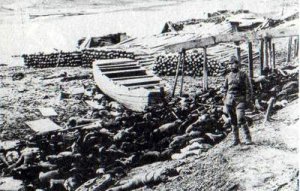![]() The Pacific War Online Encyclopedia
The Pacific War Online Encyclopedia
|
| Previous: Nanded | Table of Contents | Next: Nanning |

Never an important commercial center, Nanking
(Nanjing; 118.740E
32.110N) was a political
center from 206 B.C., and it was the capital of nationalist China
from 1927 until its capture by the Japanese
in 1940. The population at the time was in the ballpark of 1.1 million
persons. The city was protected by a 50' (15m) brick wall.
The first Japanese air raids against Nanking took place in August 1937. Following the Japanese breakout from Shanghai in November 1937, Japanese forces raced up the Yangtze valley against minimal opposition from the routed and panic-stricken Chinese forces. On the recommendation of their German advisors, the Chinese had spent over a million yuan to establish a line of fortifications in the Yangtze Valley inland of Shanghai ("the Far Eastern Hindenburg Line") to hold up a Japanese advance into the heart of China, but this was abandoned without a fight (Peattie et al. 2011). By 3 December the Japanese had seized Tanyang, just fifty miles from the capital. The Chinese defense lines were established too close to the city and the Japanese were within artillery range of the city before they even came in contact with the defenses. On 6 December the main infantry assault commenced from the east and south, and took just five days to break into the city.

The subsequent Rape of Nanking was one of the great atrocities of the Second World War and the greatest single atrocity committed by the Japanese. Estimates vary wildly, but the best estimate is that about 200,000 persons were murdered. In addition, at least 20,000 rapes of women took place, and about a third of the city was gutted by fires set by looting soldiers. This was not a collapse of discipline brought on by heavy casualties: The division most strongly implicated, 16 Division, had not fought at Shanghai and had suffered relatively light casualties in the Nanking campaign. The commander of Central China Area Army, Matsui Iwane, was later hanged as a war criminal. The justice of this sentence has been disputed, and many historians have come to view Matsui as a scapegoat, with responsibility for the massacre resting with Prince Asaka Yasuhiko, the Emperor's uncle by marriage. These historians argue that since Matsui was ill at the time of the massacre, actual command authority rested with Asaka. These historians further allege that, since the Imperial Household was effectively off-limits to the International Military Tribunal for the Far East, Asaka's role was not explored, Matsui's responsibility was little questioned, and Matsui himself was apparently unwilling to implicate anyone close to the Emperor.
Had Nanking held out longer, the Japanese had plans to bomb the city with incendiaries and mustard gas (Peattie et al. 2011).
The Panay Incident. On 11 December 1937, during the battle of Nanking, the Panay, a U.S. Navy river gunboat with the Yangtze River Patrol, evacuated U.S. embassy personnel from Nanking. The next day the gunboat was several miles upriver of Nanking when it was bombed and sunk by Japanese aircraft. The Japanese government claimed their pilots
had confused the gunboat with Chinese vessels fleeing the area and had
sunk it by mistake, and the offer of an apology and payment of an
indemnity to the United States helped avert a diplomatic crisis.
However,U.S. Navy cryptographic intelligence suggested the attack was deliberate, though this could not be revealed at the time for security reasons.
Nanking subsequently became the headquarters of China Expeditionary Army. The
airfield based 12 Ki-27 Nate of
54 Air Regiment.
References
Populstat.info (accessed 2014-6-8)
The Pacific War Online Encyclopedia © 2006, 2008-2010, 2014-2015 by Kent G. Budge. Index